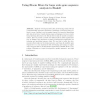136 search results - page 6 / 28 » The ed-tree: An Index for Large DNA Sequence Databases |
PADL
2009
Springer
14 years 8 months ago
2009
Springer
Analysis of biological data often involves large data sets and computationally expensive algorithms. Databases of biological data continue to grow, leading to an increasing demand ...
BMCBI
2010
13 years 5 months ago
2010
Background: We propose a sequence clustering algorithm and compare the partition quality and execution time of the proposed algorithm with those of a popular existing algorithm. T...
CIKM
2009
Springer
13 years 11 months ago
2009
Springer
A suffix tree is a fundamental data structure for string searching algorithms. Unfortunately, when it comes to the use of suffix trees in real-life applications, the current metho...
DATESO
2007
13 years 9 months ago
2007
When searching databases of nucleotide or protein sequences, finding a local alignment of two sequences is one of the main tasks. Since the sizes of available databases grow const...
BMCBI
2006
13 years 7 months ago
2006
Background: Non-coding DNA sequences comprise a very large proportion of the total genomic content of mammals, most other vertebrates, many invertebrates, and most plants. Unravel...


